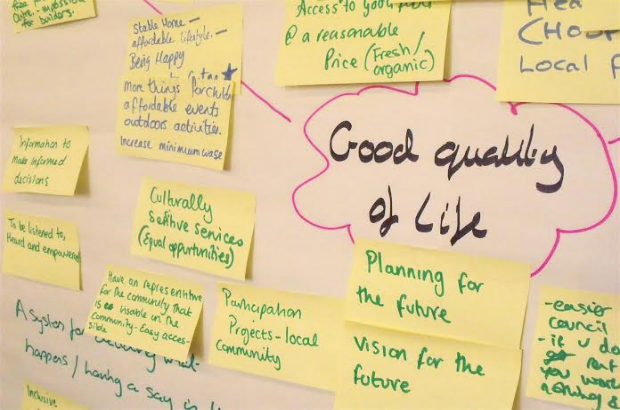
Following on from our public dialogue into wellbeing in 2014, we partnered with the What Works Centre for Wellbeing to run another dialogue, this time to help them shape their evidence programmes. The findings are published today.
The series of dialogues were held last year, delivered by Hopkins Van Mil and supported by Sciencewise and Public Health England. Meetings were held in six locations across the UK including Scotland, Wales and Northern Ireland. We brought policy-makers together with members of the public to talk about what they thought the priorities for the Centre should be and to inspire new ideas for supporting and improving wellbeing. The discussions focused on wellbeing in three areas of our lives:
- Work and adult learning;
- The wider community;
- Participation in cultural and sports activities.
Why public dialogue?
The public will be a key customer for the What Works Centre for Wellbeing, so it made sense for them to be involved in the decision making processes around what the Centre focuses its energy on. Public dialogue and wellbeing evidence are complementary, as we found out in our first round of dialogues in 2014, because wellbeing is fundamentally about people, their experiences and what matters most to them, and public dialogue gives participants the time and space to explore these in depth. Therefore, a dialogue on the work programme of a wellbeing centre made perfect sense.
Shaping the work programme
So, how did they go? These public dialogues have given us a real insight into people’s priorities in the areas we’re interested in and have helped to inform the work plans of the What Works Centre. There were some cross-cutting findings and overlapping themes which came out in all three dialogue areas, however participants were keen to emphasise the basics: Wellbeing needs included being safe and loved, having sufficient money and good physical and mental health. The opportunity to access good quality and affordable food also emerged as a strong cross-cutting theme. There was also emerging consensus around the main barriers to wellbeing, which were identified as a lack of time and money, low confidence and support, limited information and an unsatisfactory work-life balance, alongside a lack of affordable good quality housing and reliable transport.
Next steps
Academic teams at the What Works Centre for Wellbeing have already incorporated the findings from the dialogues into their work plans. These plans will be delivered over the next two and a half years, ensuring that the Centre’s outputs directly reflect the needs of the public, along with other stakeholders. Detailed findings on each of the three areas and the Centre’s work plans can be found here.
Please let us know your thoughts below.
Recent Comments